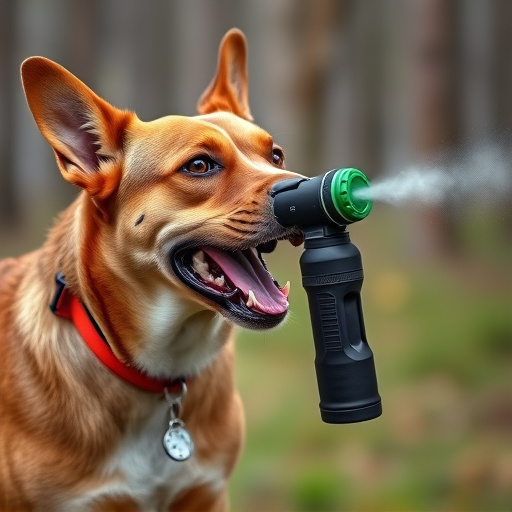Animal control sprays, or canine repellents, are designed to manage unwanted animal behavior without harm, using natural ingredients like capsaicin or plant-based oils. They feature adjustable nozzles and safety locking mechanisms for controlled application. The legal landscape varies globally, with many regions implementing strict regulations to safeguard public safety and protect animals, limiting usage to authorized personnel or specific scenarios. Safety measures, including proper labeling, user instructions, and actuation locks, are crucial. Reputable brands prioritize non-toxic ingredients, rapid degradation rates, and ecological testing, making these sprays an eco-conscious and effective solution for unwanted wildlife interactions while ensuring minimal risk to pets, children, and the environment.
“Animal control sprays have emerged as a controversial yet effective tool in managing wildlife populations. This article explores the legal and practical aspects of using canine repellents, delving into their types, applications, and safety features. We navigate the legal framework governing their use, emphasizing responsible handling and user precautions. Additionally, we assess environmental impact and provide guidelines for effective application. Understanding these key elements is vital to ensuring both animal welfare and successful control measures.”
- Understanding Animal Control Sprays: Types and Applications
- Legal Framework Governing Canine Repellent Use
- Safety Measures and Precautions for Users
- Effective Use and Environmental Impact Assessment
Understanding Animal Control Sprays: Types and Applications
Animal control sprays, also known as canine repellents, are specialized products designed to deter and manage unwanted animal behavior. These sprays come in various types, each with unique active ingredients and application methods. The primary goal is to create a safe and effective barrier between animals and desired areas, without causing harm.
Safety features are a crucial aspect of these repellents, especially when considering their legal use. Many modern formulations employ natural ingredients like capsaicin (from chili peppers) or plant-based oils, which are less toxic and more environmentally friendly. These options are often preferred for domestic settings due to their lower risk to pets, children, and other wildlife. Additionally, spray devices with adjustable nozzles and safety locking mechanisms ensure accurate and controlled application, minimizing accidental exposure and potential harm.
Legal Framework Governing Canine Repellent Use
The legal framework surrounding canine repellent spray, also known as animal control spray, varies across jurisdictions. In many regions, its use is regulated to ensure public safety and protect both animals and individuals. These laws typically mandate that such sprays can only be employed by authorized personnel or under specific circumstances. For instance, law enforcement agencies often have the authority to use them during high-risk situations, like dealing with aggressive dogs or controlling crowds of animals.
Safety features in canine repellents are a key consideration within this legal framework. Repellents must be designed and tested to minimize harm both to the targeted animals and bystanders. This includes using active ingredients that are non-toxic or minimally toxic, ensuring proper labeling and instructions for use, and incorporating safety mechanisms like actuation locks to prevent accidental discharge. Adherence to these standards helps maintain a balance between effective animal control and public well-being.
Safety Measures and Precautions for Users
Using animal control spray, especially those designed as canine repellents, requires strict adherence to safety measures. First and foremost, users should always read and follow the manufacturer’s instructions meticulously. These products often contain potent ingredients that can be harmful if misused or mishandled. Safety features in canine repellent sprays include specific application guidelines, such as aiming away from people, pets, and open water bodies, to prevent accidental exposure or ecological damage.
Additionally, personal protective equipment (PPE) like gloves and eye protection is recommended during use. Users should also ensure proper ventilation, especially in enclosed spaces, to minimize inhalation of spray particles. Proper storage is another critical aspect; these sprays should be kept out of reach of children and pets, in cool, dry places, and away from food items to avoid contamination or accidental consumption.
Effective Use and Environmental Impact Assessment
Animal control spray, often referred to as canine repellent, is a powerful tool for managing and protecting against unwanted wildlife interactions. When used effectively, it can deter animals like dogs, cats, raccoons, and squirrels from entering specific areas, offering a humane solution for both homeowners and businesses. The key lies in understanding the safety features of these repellents and their minimal environmental impact.
Safety is paramount, especially when considering repellents designed for use around pets and children. Many modern formulations incorporate safety features such as non-toxic ingredients, rapid degradation rates, and specific application guidelines to prevent harm. Environmental assessment is another critical aspect; reputable brands conduct extensive testing to ensure their products break down naturally within the ecosystem, leaving no persistent residues. This approach balances the need for effective animal control with the preservation of local ecosystems and biodiversity.
Animal control sprays, particularly canine repellents, offer a legal and effective solution for managing wildlife interactions. Understanding their types, applications, and safety measures is crucial for responsible use. By adhering to the governing legal frameworks and conducting environmental impact assessments, users can leverage these products while prioritizing safety features in canine repellent formulations. This balanced approach ensures both the control of unwanted animal presence and the preservation of ecosystems.
